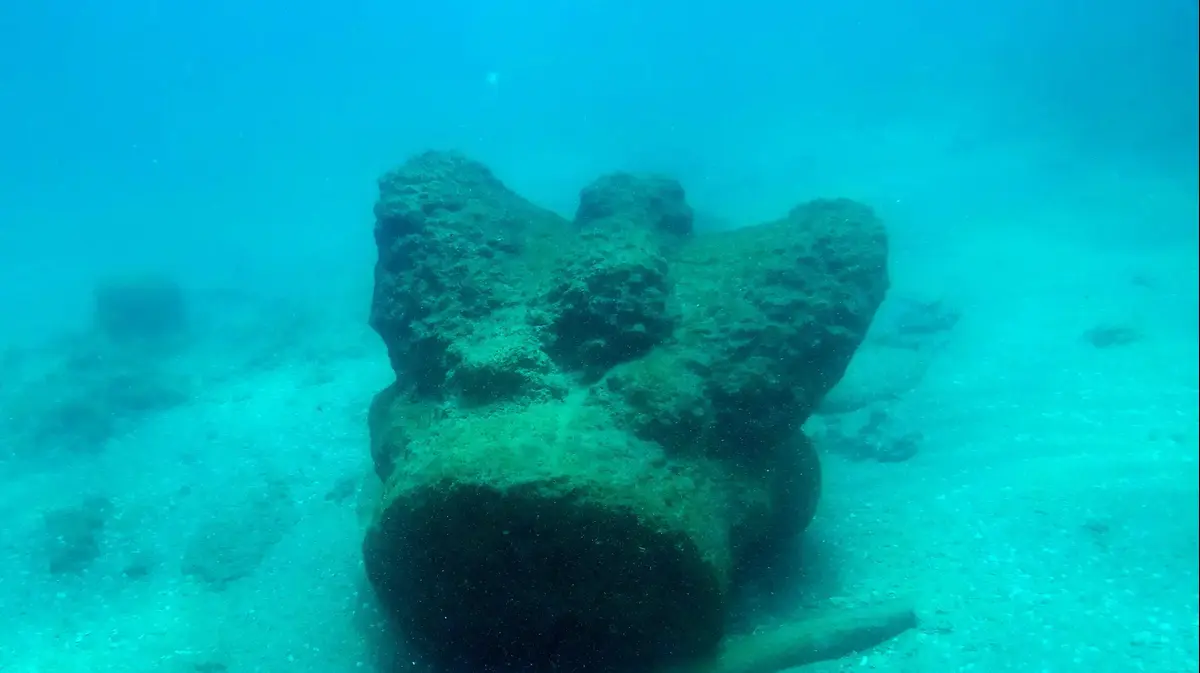A cargo of marble items about 1,800 years old was discovered in a shipwreck on the Beit Yanai coast (Photo: Marine Archaeology Unit, Israel Antiquities Authority)
A ship's cargo containing enormous marble items from 1,800 years ago (Roman period) was discovered in the waters of Yanai Beach, about 200 meters from the shore. This is the first orchard of its kind known in the Eastern Mediterranean, which includes Corinthian column capitals decorated with a plant pattern, capitals in raw condition - partially chiseled, and huge marble column beams, up to 6 m long. It seems that the valuable items were intended for the construction of a magnificent public building - a temple, or perhaps a theater.
A few weeks ago, Gideon Harris, a marine swimmer, contacted the Israel Antiquities Authority and reported ancient pillars he saw while swimming on Beit Yanai beach. This appeal pleased Kobi Sharvit, Director of the Marine Archaeology Unit at the Israel Antiquities Authority. "We have known about the existence of this IED for many years," he says, "but since it was covered with sand, its exact location was unknown and could not be investigated. The recent storms have apparently exposed the complex, and following Gideon's important report, we documented it and conducted preliminary archaeological examinations in preparation for a broader study," he says.
.
A cargo of marble items about 1,800 years old was discovered in a shipwreck on the Beit Yanai coast (Photo: Israel Antiquities Authority, Marine Archaeology Unit)
A cargo of marble items about 1,800 years old was discovered in a shipwreck on the Beit Yanai coast (Photo: Israel Antiquities Authority, Marine Archaeology Unit)
From the position of the cargo at the bottom of the sea, it can be concluded that the ship was wrecked on the spot - presumably, after the ship's crew encountered a storm in the shallow waters, and dropped anchor in a desperate attempt to prevent its erosion. "Such storms develop rapidly on the shores of Israel," Sharvit says, "and due to the maneuvering limitations of the ships, this often leads to their erosion and devouring in the shallow waters."
"From the size of the items one can learn about the width and size of the ship; This is a large merchant ship that could carry at least 200 tons," adds Koby. "Such items characterize large and magnificent public construction. Just for example, even in Roman Caesarea, the items were made of local stone coated with stucco (white plaster) to resemble the appearance of marble. Here, we're talking about real marble items."
Since it seems that the cargo originated in the Aegean region - Turkey or Greece, and the cargo was discovered south of the port of Caesarea, it seems that it was planned to reach one of the southern port cities - Ashkelon or Gaza, or perhaps even Alexandria in Egypt.
A cargo of marble items about 1,800 years old was discovered in a shipwreck on the Beit Yanai coast (Photo: Israel Antiquities Authority, Marine Archaeology Unit)
A cargo of marble items about 1,800 years old was discovered in a shipwreck on the Beit Yanai coast (Photo: Israel Antiquities Authority, Marine Archaeology Unit)
According to Sharvit, Gideon's report resolved a longstanding research debate: "Land and marine archaeologists argue among themselves about whether the items in the Roman period were already designed in their countries of origin, or whether they traveled as partially designed raw material and their final design was carried out at the construction site in the destination country. This cargo solves the mystery: it seems that most of the items left the quarry as raw materials, and were finally designed by local artists or artisans brought to do so from other countries, similar to mosaic artists who wandered from site to site by invitation."
Gideon Harris was awarded a certificate of appreciation for his good citizenship. According to Eli Escozido, Director General of the Israel Antiquities Authority, "Gideon's important report illustrated how vital citizens' awareness of antiquities is, and even more so – how important it is that such discoveries be reported to the Antiquities Authority. Citizen cooperation is of paramount value for research. We call on the public who encounters antiquities in the maritime space to take a location and call us immediately to the field. This is invaluable information for building the story of Palestine."
- tourism
- news
Tags
- Archaeology
- Beit Yanai
- cargo
- sea
- dive

